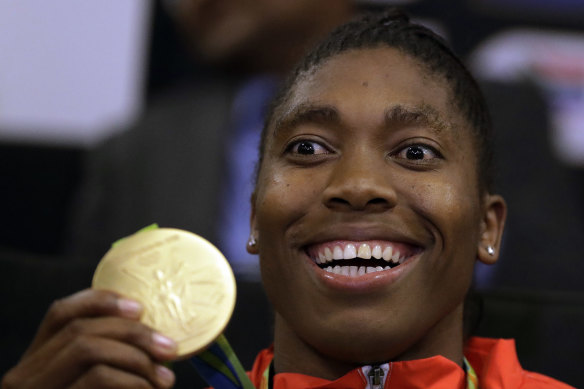This was published 3 years ago
‘I don’t care’: Semenya says she offered to show track officials her body
By Gerald Imray
Double Olympic champion Caster Semenya said she offered to show her vagina to track officials when she was just 18 years old to prove she was female. She also accused the world athletics body of making her take medication that “tortured” her and made her fear she was going to have a heart attack, according to a report on Monday in British newspaper The Telegraph.
The Telegraph published what it said were parts of an interview the South African runner did with HBO Real Sports. The full HBO interview is due to air in the United States on Tuesday.
In the interview, the Telegraph said Semenya reflected on the 2009 world championships in Berlin, where she won the 800-metre world title in dominant fashion as an 18-year-old newcomer at her first major athletics meet. But her performance and muscular physique led the world track body to order the teenager to undergo sex tests, causing a firestorm of controversy.
According to the Telegraph, Semenya said track officials from the governing body “probably” thought she had a penis.
“I told them, ‘It’s fine. I’m a female, I don’t care. If you want to see I’m a woman, I will show you my vagina. All right?’” Semenya said in the interview.
Following her world title win, Semenya was forced by the world track body to take medication that artificially lowered her naturally high testosterone if she wanted to compete against other female runners. Although the world track body has never released details of Semenya’s specific medication, it is believed she took birth control pills or something with similar properties to lower her testosterone.

Caster Semenya burst onto the world athletics scene at the 2009 world titles in Berlin.Credit: AP
“It made me sick, made me gain weight, panic attacks, I don’t know if I was ever going to have a heart attack,” Semenya said of the medication. “It’s like stabbing yourself with a knife every day. But I had no choice.
“I’m 18, I want to run, I want to make it to (the) Olympics, that’s the only option for me. But I had to make it work.”
Forcing athletes to take medication to alter natural hormone levels to compete has been criticised by medical experts as being clearly unethical. It has also never been revealed what dosage of medication Semenya had to take to lower her testosterone to a level set as acceptable by track chiefs to allow her to run.
The Telegraph reported that World Athletics lawyer Jonathan Taylor also spoke to HBO Real Sports and defended the medication, which wasn’t named, by saying leading experts said they would prescribe it for female athletes with high testosterone.

Semenya won Olympic gold at Rio six years ago, adding to her 800m triumph at London 2012.Credit: AP
Semenya also responded to that.
“Jonathan must cut his tongue and throw it away,” the Telegraph quoted Semenya as saying. “If he wants to understand how that thing has tortured me, he must go and take those medications. He will understand.”
The 2009 world championships was the start of Semenya’s 13-year battle against track authorities to be able to compete against female athletes. Now 31, Semenya is banned from competing in distances from 400m-1600m at top-level track meets in updated testosterone regulations unless she agrees to again take medication to lower her testosterone. She has refused, and hasn’t run an 800m race at a major meet since 2019. The regulations prevented Semenya from defending her Olympic title last year in Tokyo.
Semenya has one of a number of conditions referred to as differences of sex development, or DSDs. It results in a testosterone level that is higher than the typical female range and which World Athletics says gives her an unfair advantage against other female athletes.
She has challenged the testosterone regulations twice in court, losing appeals at the Court of Arbitration for Sport and the Swiss Federal Tribunal. She has launched a third appeal against them and is waiting for a hearing date to be set at the European Court of Human Rights.
Semenya has rarely spoken in detail about her experiences with the world track body, which was previously known as the IAAF and rebranded to World Athletics. However, details of the sometimes bitter battle came to light in 2019 when court documents from Semenya’s first legal challenge revealed the track body categorised her as “biologically male.” Semenya said she was outraged at a sports body “telling me that I am not a woman.”
Semenya was identified as female at birth and has identified as female her whole life. Yet some experts say that her elevated natural testosterone gives her a clear advantage against other women. Before she was banned from running in the 800m in 2019, Semenya went more than 30 races unbeaten.
AP
News, results and expert analysis from the weekend of sport sent every Monday. Sign up for our Sport newsletter.